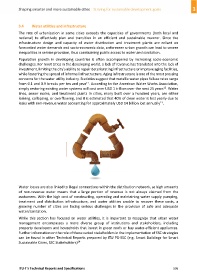Page 519 - Shaping smarter and more sustainable cities - Striving for sustainable development goals
P. 519
3.4 Water utilities and infrastructure
The rate of urbanization in some cities exceeds the capacities of governments (both local and
national) to effectively plan and transition in an efficient and sustainable manner. Since the
infrastructure design and capacity of water distribution and treatment plants are reliant on
forecasted water demands and socio‐economic data, unforeseen urban growth can lead to severe
inequalities in service provision, thus constraining public access to water and sanitation.
Population growth in developing countries is often accompanied by increasing socio‐economic
challenges. For most cities in the developing world, a lack of revenue has translated into the lack of
investment, limiting the city's ability to repair deteriorating infrastructure or improve aging facilities,
while fostering the spread of informal infrastructure. Aging infrastructure is one of the most pressing
concerns for the water utility industry. Statistics suggest that metallic water pipes failure rates range
11
from 0.1 and 0.9 breaks per km and year . According to the American Water Works Association,
12
simply restoring existing water systems will cost over USD 1 trillion over the next 25 years . Water
lines, sewer mains, and treatment plants in cities, many built over a hundred years, are either
leaking, collapsing, or overflowing, and it is estimated that 40% of clean water is lost yearly due to
13
leaks with non‐revenue water accounting for approximately USD 14 billion lost annually .
Water losses are also linked to illegal connections within the distribution network, as high amounts
of non‐revenue water means that a large portion of revenue is not always claimed from the
customers. With the high cost of constructing, operating and maintaining water supply pumping,
treatment and distribution infrastructure, and water utilities unable to recover these costs, a
growing number of cities are facing serious challenges in the provision of safe and adequate
water/sanitation.
While this section has focused on water utilities, it is important to recognize that urban water
management encompasses a more diverse group of institutions and stakeholders, including
property developers and households that invest in green roofs or buy water‐efficient appliances.
Further information on the role of these varied stakeholders in the implementation of SSC strategies
can be found in other Technical Reports prepared by ITU FG‐SSC (e.g. Smart Buildings for Smart
14
Sustainable Cities, SSC Stakeholders)
ITU‐T's Technical Reports and Specifications 509

